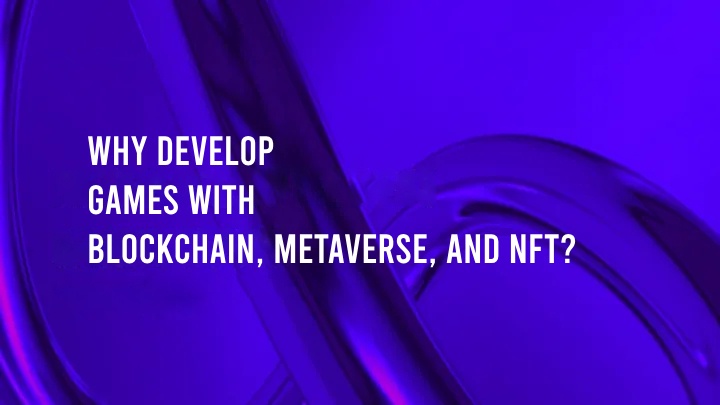In the ever-evolving realm of the gaming industry, traditional boundaries are blurring, and new technologies are reshaping the way we play and experience games. Among these transformative technologies, three concepts are gaining significant traction: Blockchain, Metaverse, and NFTs (Non-Fungible Tokens).
In this blog, we'll explore why game developers are increasingly turning to these innovative solutions.
The Gaming Landscape Redefined
Gaming has come a long way from the days of pixelated sprites and limited gameplay. Today's gamers expect immersive, dynamic, and interconnected experiences that go beyond traditional gaming. This is where Blockchain, Metaverse, and NFTs come into play:
1. Blockchain: Enhanced Security and Ownership
Blockchain technology provides a secure and transparent framework for gaming. By leveraging blockchain, game developers can offer players true ownership of in-game assets, characters, and even entire virtual worlds. These assets are represented as NFTs, ensuring their scarcity and uniqueness. In addition, blockchain enables players to trade their digital possessions securely, free from fraud and duplication.
2. Metaverse: A Seamless Digital Universe
The Metaverse is an interconnected, virtual universe where players can seamlessly transition between different gaming experiences, social interactions, and digital spaces. It's a place where users can explore, socialize, create content, and earn rewards. The Metaverse is not limited by individual games but encompasses an entire digital ecosystem, creating a more immersive and interconnected gaming experience.
3. NFTs: Digital Ownership and Scarcity
NFTs have revolutionized the concept of ownership in the gaming world. These tokens represent unique in-game assets, characters, skins, and more. When players own NFTs, they have a verifiable claim to these digital items. This newfound sense of ownership enhances the player's connection to the game and its virtual assets.
Why Develop Games With These Technologies?
1. Enhanced Player Engagement
Games developed with Blockchain, Metaverse, and NFTs offer a level of engagement and immersion that traditional games cannot match. The sense of ownership and the ability to transfer assets between games keeps players engaged in the virtual universe.
2. Monetization and Earning Opportunities
Developers can create new revenue streams by enabling players to buy, sell, and trade in-game assets using NFTs. Players can also earn NFTs as rewards for their achievements, creating opportunities for in-game economies.
3. Secure and Transparent Ecosystem
Blockchain technology ensures that in-game transactions are secure and transparent. Players can trust that their virtual assets are genuinely theirs and can be verified on the blockchain.
4. Interoperability
Games developed with these technologies can be part of a larger Metaverse, allowing players to take their assets and achievements from one game to another seamlessly. This interoperability fosters a cohesive gaming ecosystem.
5. Community Building
The Metaverse encourages the formation of virtual communities where players can socialize, collaborate, and interact. NFTs can represent digital badges or memberships within these communities, fostering a sense of belonging.
The Role of Metaverse NFT Marketplace Development Solutions
For game developers looking to harness the potential of Blockchain, Metaverse, and NFTs, the development of Metaverse NFT marketplaces is crucial. These marketplaces serve as hubs where players can buy, sell, and trade in-game assets represented as NFTs. This infrastructure connects gamers, game developers, and NFT creators, creating a thriving in-game economy.
Key components of successful Metaverse NFT marketplaces include:
1. User-Friendly Interface:
A seamless and user-friendly interface that makes it easy for players to navigate and trade assets.
2. Blockchain Integration:
Integration with a robust blockchain to ensure the security, transparency, and immutability of NFT transactions.
3. Asset Creation Tools:
Tools that allow developers and players to create and tokenize in-game assets, adding to the richness of the game's ecosystem.
4. Interoperability:
Compatibility with various games and Metaverse platforms to enable players to move their assets across different virtual worlds.
5. Incentive Systems:
Reward systems that encourage players to participate in the marketplace and the overall in-game economy.
The Future of Gaming
As game developers increasingly adopt Blockchain, Metaverse, and NFTs, the future of gaming looks promising and dynamic. Gamers can look forward to more immersive, interconnected, and rewarding experiences. The boundaries between different games will blur, and players will have true ownership of their in-game assets. Additionally, players will have the opportunity to monetize their gaming skills and achievements, making gaming more than just a pastime.
The convergence of these technologies in the gaming industry is a testament to the transformative power of innovation. As more game developers explore "metaverse NFT marketplace development solutions," the gaming landscape will continue to evolve, offering players a more engaging, secure, and interconnected digital universe. So, whether you're a developer or a gamer, get ready for an exciting journey into the future of gaming.


No comments yet